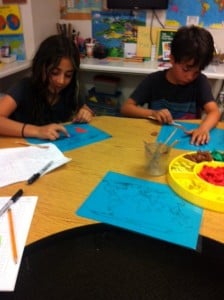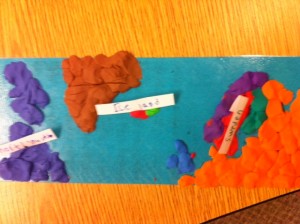 This year, in both 2nd/3rd grade geography and 4th/5th grade history, we will be focusing on the many facets of exploration. In geography we started out with the question, “What comes to mind when you hear the word ‘explorer’?” The answers were wonderfully revealing: “I see a big journey ahead of me.” “I see a penguin exploring an icy world.” “I think of someone digging down into the Earth looking at rocks.” “A guy in the jungle or looking through binoculars on top of a mountain.” “Explore means to me exploring all over the whole world and seeing new things.” “I think of exploring through books.” “I think of no maps, then you don’t know what you’ll run into.”
This year, in both 2nd/3rd grade geography and 4th/5th grade history, we will be focusing on the many facets of exploration. In geography we started out with the question, “What comes to mind when you hear the word ‘explorer’?” The answers were wonderfully revealing: “I see a big journey ahead of me.” “I see a penguin exploring an icy world.” “I think of someone digging down into the Earth looking at rocks.” “A guy in the jungle or looking through binoculars on top of a mountain.” “Explore means to me exploring all over the whole world and seeing new things.” “I think of exploring through books.” “I think of no maps, then you don’t know what you’ll run into.”
Then came the question, “Why explore?” “To go out bring information back so everybody can hear about it.” “So people who don’t know things can be taught by other people that know that thing…to learn how to make stuff out of nature.” “To discover things like bones. In Snowmass these explorers went to a lake and found a whole mammoth!”
Similar questions were asked in history class, but the focus was tighter and centered on the vikings… “What do you know or think you know about vikings?” “I think they were nomadic.” “The fact that they wore horned helmets is false.” “They’re warriors and survivors.” “I know _______ 🙁 .” “They follow the norse gods including, but not limited to Odin, Thor, Tyr, and Loki.” “They ate parts of poison mushrooms to make them brave in battle.” “I think vikings are tribes of barbarians that have laws average people would call nonsense.”
“Why might the vikings have gone exploring?” “For adventure.” “They looked for investors or traders.” “Maybe vikings were explorers because they wanted to conquer the world and or have more resources, space and to make an empire.” “Why not be a viking explorer? There’s land, food, water, and more stuff–treasure.” “Maybe they explored for the same reasons those tribes did that we studied last year. Maybe because they hunted too many of the animals and needed to follow where there were more.”
This range of thinking is thrilling to me! Students are remarkably  independent thinkers when given these types of wide open questions, and it is striking how often they tap into key elements of whatever topic we are exploring. We balance these far ranging discussions with plenty of hands-on work, such as creating clay study maps to develop a stronger sense of just where in the world we’re trying to get to and what we might find along the way.
independent thinkers when given these types of wide open questions, and it is striking how often they tap into key elements of whatever topic we are exploring. We balance these far ranging discussions with plenty of hands-on work, such as creating clay study maps to develop a stronger sense of just where in the world we’re trying to get to and what we might find along the way.
 As a bonus, another form of exploration is included here–this tower-like structure was created at our building table by a student during his free time…what surprising things surface when time, materials, and open spaces are provided!
As a bonus, another form of exploration is included here–this tower-like structure was created at our building table by a student during his free time…what surprising things surface when time, materials, and open spaces are provided!



